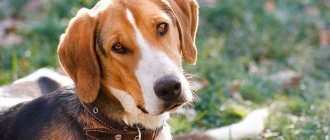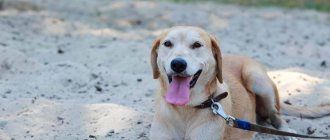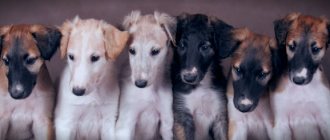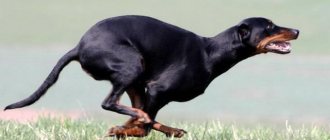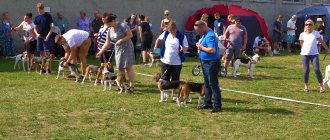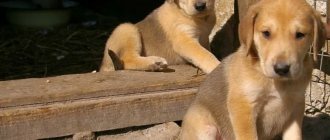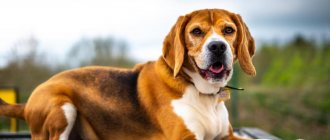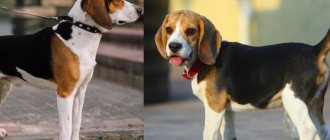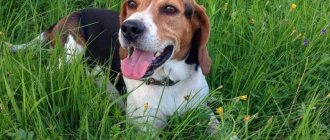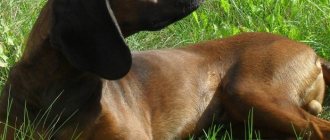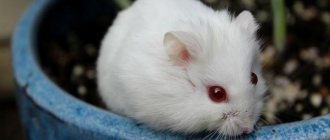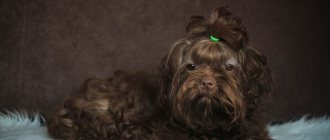Large dark eyes, a wide forehead, long paws, a muscular body, as well as a ringing voice and endurance - all these and not only characteristics distinguish hound dogs. These qualities are definitely inherent in the pride of Russian dog breeding - the Russian hound.
- 2 Table: description of the breed according to the RKF standard
2.1 Photo gallery: Russian hound standard
- 3.1 Training
Color of Russian hound dogs
The use of hounds for hunting in Russia has been known since the 12th century, and descriptions of hounds and hunting with them have been known since the end of the 18th century. Originally, hounds were BREED for a variety of hunts according to the personal tastes of the owners.
The purity of the breed was not respected, so by the end of the 19th century there was no established type of domestic hound. In 1874, with the holding of annual exhibitions, work began to create a stable type of breed. The first standards - descriptions of the breed - were developed: in 1881 - under the name “Eastern Hound”, and in 1895 - under the subsequently established name “Russian Hound”.
After 1917, hunting with hounds became the property of the broad masses of hunters, and as a result of the selection work carried out, the modern breed of Russian hounds was created.
General appearance, height, build and behavior
The Russian hound is somewhat reminiscent of a wolf in appearance, especially with its high front and the way it holds its head low. The Russian hound has that bestial appearance that distinguishes it from all other breeds.
The dog is above average height, strong build. The height at the withers for males (males) is 58-68 cm, for females (females) 55-65 cm. The height at the rump is 1-2 cm less than the height of the dog at the withers. The stretch index (format) for survivors is about 105, for survivors - about 107. Type of behavior - calm, balanced. Sexual dimorphism is pronounced.
Typical gait: when searching for an animal - a sweep (gallop) and a wide trot, when chasing - a sweep.
Disadvantages: Height is HIGHER than specified in the standard by up to 2 cm; NOT SIGNIFICANT. EXPRESSLY short-legged or long-legged, excessively stretched or shortened (TO square) format; slight deviations towards lightness, dampness or roughness, timidity.
Color. Black-and-white, light-black, crimson (shades from reddish-yellowish to yellowish-light) and underhair ( grayish with whitish tan). With the saddle color, the back and sides are black or gray, the saddle fades into yellow blush covering the legs, belly, chest and head. It is acceptable to have individual evenly distributed gray hairs in the saddle cloth - “saddle cloth in silver.” With a crimson color, the dog is red-yellow or yellow-light on the back and sides, lighter on the rest of the body. The light-saddle color differs from the saddle-back color in the general lightening and less contrast between the saddle and rouge, as well as the smaller size of the saddle. With an underhair color, dark hair on the back and sides alternates with lighter hair, forming an overall grayish tone, the tan marks are whitish. In any color, small white markings on the chest and legs are acceptable.
Disadvantages: saddle cloth with sharply defined borders, reddish BLUSH, white SPOTS on the LIMBS extending onto the wrists and metatarsals, small white marks in places not specified by the standard, blackness on the temples in dogs over one and a half years old.
Faults: bright red blush, speckling, large white spots, including on the LIMBS above the carpal and hock joints, as well as dark spots on the forehead, ears, lips and above the eyes.
Disqualifying faults: mousey or coffee colored.
Dog meat (wool). It is short on the head, ears and legs, and longer on the rest of the body, especially around the neck and on the backs of the thighs. On the rut (tail) the dog is of medium length, shorter towards the end. Characterized by a thick, soft undercoat.
Disadvantages: glossy, long, short, slightly wavy dog, underdeveloped undercoat.
Faults: shaggy, wavy coat, lack of undercoat.
Bones, muscles, skin: The bones are strong. The muscles are dry and well developed. The skin is dense, elastic, without noticeable development of subcutaneous tissue and folds.
Disadvantages: slight weakness of bones and muscles, looseness. The presence of a skin growth (papilloma) on the lower part of the chest that does not extend beyond the fur.
Defects: rough bones, poor bones, looseness. The presence of a skin growth (papilloma) on the lower part of the chest that extends beyond the fur.
Head. Dry, wedge-shaped, relatively small . The skull is oblong, flat on top. The line of the skull and muzzle is parallel. MODERATELY WIDE IN THE CHEEKHOODS, the occipital protuberance and brow ridges are weakly defined, the transition from the forehead to the muzzle is smooth. The muzzle is elongated, wedge-shaped. The nose is wide, somewhat protruding, and black. The lips are dark, tightly fitting to the jaws , without drooping or jowls.
Ears. Small, hanging, MODERATELY thin, relatively short, triangular in shape, close to the head, set slightly above eye level.
Disadvantages: TOO LARGE, with a round edge, thick, set TOO HIGH OR LOW, tight, loose fitting.
Defects: raised on the cartilage, rolled into a tube, too large.
Eyes. Dark brown or brown, medium SIZE , with an oblique cut to the eyelids, the edges of the eyelids are dark.
Faults: LIGHT, SMALL, DEEP-SET, STRAIGHT-SET, with a rounded eyelid, with sagging (light) edges of the eyelids.
Faults: LIGHT (YELLOW) EYES.
Disqualifying faults: odd eyes, greenish and bluish (porcelain) eyes.
Teeth and bite. The teeth are white, strong, large, well developed, tightly adjacent to each other. Scissor bite. The dental formula is complete.
Disadvantages: small, sparse or teeth with PARTIAL CARIES . It is acceptable to have one or more teeth from the first premolars (P1) and the last lower molars (M3) that DO NOT AFFECT THE SCORE, BUT NOT MORE THAN 3 TEETH. Pincer bite after the age of six (if the bite was previously recognized as correct). Presence of one or two extra premolars. The absence of one premolar FROM P2 and P3 DOES NOT AFFECT THE SCORE, BUT IT AFFECTS the place in the ring, the absence of two premolars from P2 or P3 the score is not higher than very good.
Defects: absence of three or more premolars from P2, P3 or one lower P4, presence of three or more extra premolars, presence of one extra canine (score not higher than GOOD).
Neck. Muscular, dry, APPROXIMATELY EQUAL TO THE HEAD IN LENGTH The neck is set LOW, forming an angle of about 30-35 degrees in relation to the horizon. The neck is evenly covered with a rather long Neck, forming a “scratch”.
Disadvantages: NOT MUCH ENOUGH, RAW with a chin (with loose skin on the neck), set on a little high, SHORT, TOO LONG, dressed in a shortish dog.
Withers. Well developed, stands out above the line of the back.
Disadvantages: underdeveloped.
Back. Straight, wide, muscular.
Disadvantages: a bit soft, over-tracked.
Faults: sagging, hunchbacked.
Small of the back. Short, wide, slightly arched and muscular.
Disadvantages: a little elongated, narrow, straight , too convex.
Faults: LONG, NARROW, HUMPBACK, weak.
Croup Wide, slightly sloping, moderately long.
Disadvantages: Narrow, straight, slightly skewed.
Faults: NARROW, sharply sloping.
Breast. Deep, LOWED TO THE ELBOW OR A LITTLE BELOW, Wide.
Conversation-interview with E.I. Pogadaev
Conversation-interview with E.I. Pogadaev about the past, present and future of Russian hunting cynology, about his views on breeding, examination and the Russian Hound breed.
Pogadaev Evgeniy Ilyich has been an RORS expert since 1991, conducting examinations in many regions of our country, at exhibitions and tests from the regional level to the All-Russian level, a breeder of Russian Hound dogs, with which he held numerous titles Champion of exhibitions and competitions. The man who created the cynological activity of the Mari Society of Hunters, the results of which thundered in the hunting dog breeding of Russia and the CIS for two decades. Initiated and conducted numerous competitions for hounds and other breeds of various levels. He was a member of the Russian Canine Council for many years and is an Honorary Member of RORS. Many years of communication with the masters of hunting cynology did not pass without a trace, and from a young proactive hunter-dog breeder Pogadaev E.I. He himself became a mentor, having his own vast and successful experience. He is an excellent dog trainer, a thoughtful, experienced dog trainer with an “eye” for breeds, a renowned breeder with an inherent flair, a wonderful family man and the life of the party - here is an illustration of the versatility of talents!
Interview - fireside chat:
1.Question :
How did it all begin many years ago? How did you become so interested in dogs that you connected your life with them?
…Answer:
I myself grew up in the countryside, and the forest was a part of my life. When I was in 3rd grade, my father was given a Russian hound named Jack. And then, two years later, I either listened to Jack drive right from the window of the house, because the house was next to the forest. Or when I went hunting as a boy with my father, I enjoyed how Jack drove, giving out different voices. To this day, the beauty of this polyphony from one dog is in my memory. That's when I fell in love with hound hunting. Before the army, at the age of 17, I bought an RPG puppy for fabulous money, at that time. And when I returned from the army, in 1981 I was given a puppy RG Silva - the ancestor of the blood of my dogs. It was then that I decided on my favorite breed. The blood of rg Silva flows in my dogs to this day.
2. Question:
Many hunters and dog breeders (hound and wolf breeders) can proudly call you their Mentor.
Who did you study with? Who were your teachers? In your opinion, is continuity in cynology important, or today everyone can undergo training on the Internet, in which the role of a mentor is no longer so important?
… Answer:
My mentors were: Konoplev I.I. - expert of the 1st category on likes; Potekhin V.M. - exp. All-Union category for hounds, huskies; Zimin P.E. — exp All-Russian category for hounds; Tumanov V.P. - Category 2 expert on hounds. I also trained in the field and in the rings with Chekulaev E.K. - expert of the All-Union category on hounds, Pashkov S.M. - All-Union category expert on hounds.
Of course, continuity is very important; self-education alone will not get you far.
3. Question: You are a contemporary of the stages of canine changes in the USSR and Russia for 40 years. Can the current state of Russian hunting dog breeding be called a decline?
How have hound breeds changed?
..Answer:
In quantitative terms, probably a decline. But the quality of rise and development is evident. 40 years ago, you sometimes looked at some hound and doubted whether it was a mongrel? And now the breed is higher, and in terms of working qualities there are many hounds of a high level.
4.Question:
What exactly attracted you to hounds and specifically the Russian Hound? Appearance? Character? What are the main advantages of this breed? And does it have any disadvantages?
..Answer:
Dogs of this breed are not angry, soft, social, with intelligence. The main advantage of this breed is its Voice, passionate in its delivery and readable during the rut.
5.Question:
Please tell us about the most outstanding representatives of the Pogadayev plant. Is your ideal hound among them?
..Answer:
There have been many hounds in my hunting life, but the most outstanding according to one criterion or another were: ch.pch Pevka, ch.Batrak, Plakun, Pylay, ch.Zvonka, pp.Poteshka, ch.Avos, Agat. All these dogs are in many pedigrees of the RG breed. I would call the ideal hound for myself, of course, Pevka Pogadayev. No matter what kind of hounds I talk about, I will always mention Pevka for various reasons in conversations (either for her voice, or for the race itself, skill, flair, or for her exterior, or for her offspring), that’s what she was like.
6.Question:
Do the titles of a dog give an unconditional right to breed it or are some other parameters needed for this?
..Answer:
It is not the titles that give the right, but the exact pedigree, the truthful price, and the merits of the exterior - these are the parameters that give the right to breed.
7.Question:
How important do you care what other experts think about your dogs? And is it true that the breeder should be the strictest judge of his own dogs?
…Answer:
The opinion of experts who have proven themselves to be excellent specialists is very important to me. I highly value you as an expert, Vyacheslav, and for this reason your opinion is always important to me, if you have noticed this - often when you come, you criticize and I listen. What would we do without this?!
Of course, the breeder himself must be the main judge of his dogs and his activities. I personally am a very strict judge for my enclosure.
8.Question:
Today, many people recall with some nostalgia those very Soviet times when the mating plan was approved by the club. What do you think, the position of the FCI and RORS is that a breeder is any owner of a bitch, with different levels of education. Does this correspond to the Russian mentality? Or is there still a need for some kind of control on the part of the clubs over the activities of “Aunt Masha” and “Uncle Vasya”? Is there a minimum compulsory education required for a breeder and in what disciplines?
..Answer:
Of course, minimal education, in the form of courses lasting a few hours or in the form of a desktop manual from the basics of keeping options, dog training to the section of breeding and veterinary measures, and standards for hunting dog breeding, are necessary for dog owners, and even more so for owners of bitches (hatchlings), since it is they who bear the responsibility for the selection of pairs (for the further development of a particular line or family). And we need control in our country, where would we be without it?! To avoid irreversible consequences in the liberties of breeders.
9.Question:
If possible, share the secrets of success with racers! How do you select a couple, what are you guided by first?
..Answer:
And this is not a secret at all, but simply the basics of animal science: “The best with the best” - taking into account the type, grades and diplomas. The main selection is based on genetics - pedigree, origin.
10.Question:
What is more beneficial for the livestock - a strict or gentle judge? Or should we look for a middle ground in everything? What should an expert judge be like today?
…Answer:
We need a “golden mean”. The expert must be objective, self-possessed, thinking, observing the ethics of an expert, able to argue his opinion and be an active hunter and owner of dogs of this breed. A true expert is distinguished by an undisguised love for the breed.
11. Question:
I believe that titles have depreciated in value compared to the times before the transfer of land into private hands.. The reason for the depreciation is the trend of scandalous Show Champions and the large number of field champions from various commercial events. What is your opinion on this matter?
…..Answer:
Indeed, titles in the old days were more significant. And the fact that there are a lot of them now is good. The breeder himself will figure out who to breed with.
12.Question:
Breed standard. Is this the bible for every dog breeder and expert? It is clear that the owners consider their dog ideal, but that’s why experts are experts in the breed, so that everything can be clearly explained and assessed... Why are there such discrepancies among many experts and breeders?
….Answer:
The standards were written succinctly and were designed for trained specialists who had been trained by luminaries and mentors, and that was enough. But another time has come, where people are more educated and the language of standards for them does not reveal a detailed description of dogs. Experts do not sit at the same desk; they speak differently and each has their own training and experience. As far as I know, painstaking work is currently underway on additions to the standards of hound breeds.
13.Question:
Describing the dog helped breeders see the dogs' flaws. Today we often see descriptions in the style of “good head, not bad looking, good movements. Rated "very good". Why does this happen, where is the argument for the assessment? Did the ability to give reasons for assessment and writing reports stimulate judges to develop? It is so?
….Answer:
Of course, this is true, you need to briefly and skillfully justify this or that assessment, but not everyone can do this. Either because they are constrained and cannot speak in front of the public, or because their knowledge is very minimal - the category is ahead of knowledge. Not everyone is given this, and the selection of experts in this area is superficial. There are no publications by high-category experts. What should receivers learn from?
14.Question:
The general trend of blood hunting dog breeding today is sad, especially for domestic hound breeds. The state, represented by the authorities, has itself distanced itself from dog breeding in general. In the current law on hunting, a hunting dog is considered to be the dog with which you go hunting - and its documents and purebred are not important to anyone. Breeders are reducing the number of litters because they cannot compete with the modern “poultry market” - Avito and other message boards. Hounds are undeservedly the cheapest breeds. Why do you think this happened, since purebred dogs have always been prestigious? And now: Exhibitions are empty, many people want a dog “for themselves”, without documents. But there are not much fewer dogs in the forests!!! Is it necessary to conduct some kind of educational work in the country? And what needs to be done so that, in addition to “Meat hunts,” aesthetic types of hunts with dogs take over????
….Answer:
Of course, educational work should be carried out from different sources. There is a TV channel “Hunting and Fishing”, where they show videos from hound hunts. but this is certainly not enough. It is necessary that the source of education be the hunting and cynological organizations themselves, but they also distance themselves from the education of hunting with hounds, aesthetics, sportiness, and culture in the end. It is imperative to make additions to the “Law on Hunting” in the form of a law on hunting dogs, their breed, identification of breeds and benefits for hunting with them. Without this, hunters do not need documents for dogs and the “Bird Market” will flourish.
15.Question:
Is commerce in Russian dog breeding a new reality of cynology or just a stage of development?
….Answer:
This is a new reality necessary for the development of blood dog breeding.
16.Question:
Is breeding a hobby or a profession?
….Answer:
This is a hobby. Many different topics: Pigeons, fish, dogs of different breeds. And I like to hunt with hounds and do breeding.
17.Question:
Over the past 10 years, the gene pool of the Russian Hound has been depleted and there are many reasons for this. In my opinion, the main reasons are the restriction of racing, the reluctance of hunting users to see hounds on their lands, the impossibility of conducting tests in the regions, the attribution of commercial events (a narrow circle of surnames) to selection, as the basis of the breed for slave qualities. Outbreeding in the breed is practically excluded - what is the way out of this collapse? ……as one of the options is to create a sperm bank of outstanding producers?
….Answer:
A sperm bank is, of course, a progressive solution to many issues, but it requires serious money and specialists. The situation regarding the gene pool is complex, but it can be changed if we turn our attention to the livestock - this includes encouraging hounds without diplomas at exhibitions, this includes increasing the frequency and breadth of testing, this is the partial lifting of restrictions on breeding dogs, this is the publication of various analytics by experts.
18.Question:
Unpredictable heredity in the Russian Hound breed - what are the reasons? how to solve this?
….Answer:
I read, Vyacheslav, your article “The Russian Hound and Two Priority Tasks” and I really liked the article, in it you raise this issue with heredity and you indicate the reasons precisely. To put it succinctly, there is a need for document flow, cleanliness of owners and experts, and minimal education of breeders.
19.Question:
Russian hound - what kind of dog is it? Draw a figurative picture of her business card? Give examples of outstanding breed Russian hounds?
…Answer:
For me in life there is no more beautiful, more harmonious, more closely related Russian hound than Tuman Emuranova. Those who remember will agree with me, and those who have not seen this survivor, I recommend finding a photo. In my opinion, Plakun Tkachenko had the ideal head…..These dogs formed my requirements for the breed of Russian hound….
20. Question:
Traditionally, in Russia, the fate of dogs in different breeds RG, RPG and EG is decided by the same people. I am sure that only breeders themselves and breeders within a separate breed club can both react sensitively to changes in the breed and make the necessary additions or changes to standards and regulations. What do you say about this?
….Answer:
Yes, dividing into breed clubs will be more useful for the breeds themselves. People who know and love the breed should develop and protect it, and raise experts in their breed.
21.Question:
The division of the RG breed into “sects” in quotes - Sergeevsky, Kostromichi, Golosistye, Chutistiye, etc.... in my opinion, this is a way to stand out, attracting the attention of onlookers. They are ready to turn all sorts of rubbish into legends.....and this dismantling of the breed comes from its degradation, and degradation in dog breeds comes with the obsolescence of standards - show and field standards, etc. Would you like to hear the word “masters” on this matter?
….Answer:
Of course, these are all attempts to stand out from the general background using the scale of our country. Well, this is loudly said about degradation, but the standards, if the circumstances of hunting with breeds and for other reasons require it, of course need to be supplemented for the benefit of the breeds... The breed must be typical and recognizable - head, rut, neck set, fur coat and other features, without some subtypes, regardless of region.
22. Question:
From Latin, “show” means “to show”, and what a dog show is is a zootechnical event - a review - a display of the results of breeding work.
So why is it that today in many breeds the problem of separation into show and working lines is widely discussed. There is an opinion that working dogs differ significantly from show dogs in type, etc... The founder of the RKF, Evgeniy Yerusalimsky, said in an interview: - “ This division is artificial.
This is due to the fact that there are many people who are interested in only one direction out of two, and there are very few breeders who are interested in both directions. In the ring we focus only on the standard; there should be no concessions for the working class. The exception is some kind of injury in hunting dogs, but the exterior must meet the standard. Everyone competes on equal terms.” What do you say, Evgeny Ilyich? ….. Answer:
It is undeniable that we ourselves, humans, separate dogs. I myself love the breed and its beauty, and I keep dogs that I admire and proudly show to friends at shows. And there are people who are interested in a dog that drives in the forest and its breed means nothing to them - these are the users who come up with different divisions. I believe that the Russian Hound should be excellent in everything - both in hunting, in maintenance and in appearance.
23.Question:
Before the adoption of the Bonitation in 1951, exhibitions were held more than one day, with many prizes and dogs were presented in 10 classes (the working class was one of...) The hound breeds had a comprehensive development from the mass of different types of dogs after the revolution and those that survived the Second World War. 1951, at a time of equality between people and public lands, with a built-in universal system of tests and competitions, with the introduction of the Comprehensive Evaluation of Dogs, exhibitions were also a holiday and were massively attended... Today, the requirements for slave qualities remained the same and the main ones, but the lands became private, where not everyone tolerates hounds (for example, I was denied a ticket to the grounds of five out of six districts after learning about hounds). We exclude purebred hounds from dog shows, because without diplomas there is nothing to do at shows (a diploma at any cost) - hence By the way, there is also a shortage of the gene pool. Is it skewed? Local exhibitions of the PORS system are becoming empty. How important are exhibitions in the development of the breed? And what do you think the exhibition should be like tomorrow in 2021, taking into account the conditions in which hunting breeds find themselves today?
….Answer:
There is no clear answer to such questions. I agree that hunting with hounds is not desirable on many farms today. Carrying out tests is becoming increasingly difficult, and in some cases they have stopped altogether. I agree that there are fewer registered dogs at RORS shows. A dog show is the most important selection event - a review of the condition of the breeds. Therefore, with the transition to dividing land into different private hands, it is advisable not to discard dogs without diplomas, but to add an “Open class” for them, so as not to lose high-breed dogs from the sight of breeders. And what exhibition is needed in 2022, I sent you all my wishes for writing the regulations for the Interregional exhibition of hound dogs “Memorial of R.I. Shiyan”. These are the kind of exhibitions that breeds and breed groups need. I hope this exhibition will be grandiose and you, as the chairman of the organizing committee, will be able to implement all your plans.
24. Question:
How important is such a factor as handling - the ability to show a dog in the ring? And the arrival of the hounds “in the field”?
…Answer:
both are very important elements. This is directly related to convenience and organization in keeping and hunting. It often happens when a dog does not know how to walk in the ring (is not leash trained) and as a result receives a lower grade than it could. I myself am not I love untrained dogs and always devote time to training them.
25.Question:
In many countries, their breeds of hunting dogs are a national treasure and the residents of this country know about it. In our country, the last obvious fact of recognizing breeding dogs as a national treasure was during the conservation of livestock, through the allocation of rations to animals during the Second World War. Do you think E.I. Are our domestic breeds of hunting dogs RPB, RG, RPG, LZS, LRE, ROS worthy of being recognized by the state as a national treasure of the country? and is it timely to allocate preferences for these breeds, indicating this in the Law on Hunting?
….Answer:
It is sad that the “Law on Hunting” does not indicate in any way the breed of dogs and the affiliation of breeds to certain types of hunting. I hope this is temporary and reason will prevail. Right now it is necessary to actively support the RORS program aimed at supporting domestic breeds of hunting dogs. And the next step is to achieve recognition of these breeds as a national treasure or the pride of our state.
Questions and short answers during the hunt with Pogadaev E.I.:
- Question:
How much does the field life of hounds cost a retired hound dog - training, participation in tests, competitions, hunting?
….Answer:
It’s very expensive, it’s hard financially even to get an initial assessment for a dog, and even more so for one diploma. Competitions for retirees are tantamount to a “trip abroad.” Once upon a time, upon retirement, an interesting life began - exhibitions and tests, competitions, but now I would like to have no opportunities Enough. Every hunting trip you first calculate “in your pocket”.
- Question:
Do modern rules for testing hounds meet today's requirements for the breed? for example by viscosity? by paraty? by votes?
……..Answer:
Yes, everything is acceptable.
- Question:
What is a diploma for you? How can the current depreciation of a diploma be returned to its previous strong position?
……..Answer:
A diploma is a dog’s working passport. And this passport should not be fake or strained, but should truthfully answer for her working qualities. Then the authority of the diploma will return. People are the main cause of all troubles, not dogs.
- Question:
What voices do you look for in hounds?
………Answer:
Bright, melodious, high tones, musical, readable during the rut.
- Question:
Which hound excites you in the woods?
……..Answer:
I'm always worried about the bright, intense rut.
- Question:
Is the skill of a hound an innate or acquired quality?
……..Answer:
Congenital
- Question:
In your opinion, is the Eastern type hound – also known as the Russian hound – a parataya dog or what?
……..Answer:
Parataya
- Question:
Why does the standard in the form of current rules allow into the breeding stock a dog with a vicious viscosity, on foot, a stray, with the voice of a mongrel?
…….Answer:
This is precisely the problem with the current rules. You just need to pay attention to this and change it for the benefit of the hound breeds. There would be a goal and people!
- Question:
Navigators, shakers and their use by owners and experts - is this for the good or does it also have a negative side?
…….Answer:
Only for the good! This is a huge help.
- Question:
What field activities should be considered the main Selection activities?
……. Answer:
Regional tests
Questions and short answers in the dog enclosures of Pogadaeva E.I.:
- Question:
How many hounds do you usually have?
…….Answer:
2 or 3 hounds and puppies for growth
- Question:
Who prevails? Vyzhlovki or Vyzhlovki?
…….Answer:
I love both equally
- Question:
What requirements must a hound meet in your enclosure?
…… Answer:
Working, exterior, beautiful
- Question:
Noise, howling, dog fights - how do you manage to stop all this?
…… Answer:
Drissura - carrot and stick
- Question:
Dogs from puppyhood need veterinary care - these include vaccinations, helmitization, various preventative measures, injections and treatments - who does all this in your enclosures?
……Answer:
Only myself, and in my absence my main assistant is my wife.
- Question:
Your dogs are always shiny and well-fed. How and what do you feed?
….. Answer:
Feeding is 50% of the exterior of puppies. The same goes for the health and stamina of adult dogs. I feed puppies 5-6 times a day, adults 2 times a day. I feed meat, less often fish, brewed porridge from ground wheat, barley, crushed oats)
Question:
At the end of our conversation, I would like to wish you health and strength for the benefit of the development of your favorite breed. And what will you, Evgeniy Ilyich, say to the readers of the racers, ending our interview - conversation?
….Answer:
First of all, I want to thank you for your attention to my humble person. I hope that nothing will prevent you from holding the exhibition “Memorial of R.I. Shiyan”, I hope that the interview with me is the beginning of a series of your interviews with breed breeders. And to all lovers of hounds and hunting with them, I wish to love and enjoy and protect these breeds from claims and decline. Appreciate the beauty of voices and be proud of our national treasure.
Sincerely, lover of Russian hounds
expert II category V.Yu. Kudryashov
Gorodets, Nizhny Novgorod region.
Russian hound
Health
Character
Activity
Tendency to train
Security and guard qualities
Attitude towards children
An indispensable fox and hare hunter is the Russian hound. The breed was specially bred for hunting. Owners value these dogs for their unsurpassed endurance, performance, and also for their legendary musical voice.
Content:
The Russian hound is rarely kept as a pet that does not take part in hunting. She needs space and the excitement of chasing prey. This is a loyal, friendly friend for all family members.
Other names: Canis lupus familiaris, russkaya-gonchaya
Characteristic diseases
Despite the excellent health, the breed still has a certain tendency to certain problems.
Among the diseases characteristic of Russian hounds are:
- Conjunctivitis is an inflammatory eye disease that often becomes chronic. Especially if you don't take your dog to a vet appointment on time.
- Myositis is muscle inflammation of a different nature (eosinophilic, purulent, rheumatic). Swelling occurs in the tissues, which is accompanied by progressive lameness.
- Degenerative myelopathy is dangerous for older individuals and is expressed in disease of the spinal cord. The dog begins to lose coordination, the back of the body falls to the sides, the animal falls on its hind legs. There is no pain.
- Malignant hypertemia is a common negative reaction in dogs to general anesthesia.
- Hip dysplasia is usually a congenital joint problem that can only be diagnosed in a one- to one-and-a-half-year-old puppy.
History of the breed
For the first time, Russian hounds became known in the distant past, namely in the eleventh century. But at that time in Rus', hunting dogs were not at the peak of popularity.
With the advent of the fifteenth century, it became fashionable among rich people and nobles to have large kennels on their property, where numerous packs of greyhounds and hounds were kept. Merchants, boyars, landowners and royalty often organized entertainment as a dog hunt.
Owners of Russian hounds called their pets “yappers”, all because of their special loud bark while chasing prey.
It is believed that the Russian hound descended from a large-sized ancient Russian breed called the Medelyanka. Medelyanki were famous as unsurpassed fearless bear hunters.
Unfortunately, this breed has become extinct.
Also among the direct ancestors of Russian hounds are the Tatar hounds, which entered the territory of Rus' during the Tatar raids.
In the eighteenth and nineteenth centuries, the popularity of the Russian hound was at the highest level. But this played a cruel joke on the representatives of the breed.
Almost every owner of a hunting pack was involved in breeding hounds; during breeding work, haphazard crossbreeding was carried out.
As a result, their exterior was so diverse that many hunting dogs that had absolutely nothing to do with this breed began to be called Russian hounds.
By the end of the nineteenth century, stability had established itself. The Russian breed standard was established in 1895. But the International Federation of Cynologists has not officially recognized the Russian hound as an independent species.
How to choose names for hounds
Even Russian landowners and hunting enthusiasts of past centuries paid special attention to the names of hound dogs from their packs. The names for boys and girls were chosen sonorous and mostly short.
Of course, any name the owner likes can be suitable for a hound dog, but it is worth remembering that in a year from funny lop-eared boys or mischievous girls a large, strong and muscular animal will grow up, so it is better to refuse overly gentle names for pets. In any case, the names of the hounds need to be chosen to be sonorous, so that the name is easy and clear, so that the dog can hear it at a great distance. Such a nickname guarantees the owner complete mutual understanding and coordination of actions with his pet during the hunt.
Many follow the traditions and fashion of Tsarist Russia, choosing a name among the popular nicknames of those years. The hound bitches and dogs were called: Pulka, Raise, Yula, Bushuei, Screamer, Faithful, Zador, Zvonok, Shooter, Storm.
The names of hound dogs can refer to four areas:
- The nicknames of lop-eared hounds for boys and girls who are not related to this breed (John, Jack, Bucks, Gina) are considered atypical.
- Nicknames that characterize the voice of a hound (Bell, Screamer, Bass, Flute)
- Names that describe dogs at work (Runner, Zagonayay, Dobyvayka)
- Nicknames that describe the manner in which a dog pursues prey and the characteristics of its behavior at this moment (Cry, Song, Whistle, Noise).
Breed standard
An uninformed person can easily confuse a Russian hound with an Estonian hound. There is nothing surprising in this, since these dogs are not much different. According to the standard, the Russian hound looks like this.
The height of adult individuals is 55-68 cm , weight is about 30 kg .
There is something wild and predatory in the appearance of the Russian hound. She in some ways resembles a wolf; this similarity lies not only in her “bestial” appearance and unimaginable endurance, but also in the manner of keeping her head down, in the ability to quickly adapt to the environment and to natural adversities.
Neck without skin folds. The head is held on it in the shape of a wedge, dry. The ears are triangular in shape, relatively small in size, hanging. The eyes are brown.
The muzzle is elongated. The nose is large and protrudes slightly forward. Black color. The jaws are powerful. The teeth are large. Scissor bite, without gaps.
The withers are well defined. Elongated body. The back is strong, the loin is wide. The chest is deep. The belly is tailored like all hounds.
Length of tail to hock. Thick at the base, tapering towards the end. When excited, the Russian Hound carries its tail raised slightly above the line of its back. If the dog is calm, it is lowered.
The limbs are long and muscular. The paws are oval in shape, the toes are arched and fit tightly together.
Walk: sweeping trot or sweep. When hunting game, the Russian hound starts to gallop.
The fur on different parts of the body is not the same:
A coat that is too long or wavy is considered a serious fault.
There is a thick undercoat.
Color of the Russian hound: black-backed, light-black, crimson, grayish. Minor spots on the paws and chest are not considered a fault. The tan marks are not bright, without a sharp contrast with the main color.
Features of care
Caring for and raising a dog is not so easy. It is important to follow several rules that will help you establish contact with your pet and raise a smart, useful, and loyal animal.
- The dog must immediately respond to the owner’s call;
- The pet knows for sure that the owner is in charge, but he will never hurt or yell;
- The dog’s hierarchy is strictly observed; manifestations of dominance over a person are not allowed;
- Execution of basic commands is flawless.
If you initially base your communication with your dog on these rules, there will be no problems in the future.
Animals are sensitive to care and care. They love affection and are devoted to their owner and his family members.
Advice! Do not keep your Russian Hound with other animals! This dog doesn't get along with them, especially cats.
A pack of Russian hounds with prey
Maintenance and care
Special conditions for keeping a Russian hound are not required. Representatives of the breed can easily tolerate both heat and cold. They are unpretentious and quickly adapt to their environment.
Some features of the hound need to be taken into account. For example, keeping a freedom-loving dog on a chain is not recommended. She doesn't make an ideal watchman; if she is chained, she will become irritable and angry.
The Russian hound also does not feel comfortable in a house or apartment, and will cause inconvenience to the owners with its innate hunting instinct. Such a pet needs space, the ability to move and run.
The ideal option for a hunting dog is a private house with a garden plot. Install a spacious enclosure with a large, warm booth in the yard. But a Russian hound should not sit locked in an enclosure all the time. If she does not participate in hunting, arrange regular hikes for her in nature, in the field, in the forest.
Walk your pet daily if you keep it indoors. Two long walks are required. At the same time, keep in mind that no matter how well-mannered and trained the dog is, never let him off the leash in crowded places.
At any moment, the Russian hound's hunting instinct will come to the forefront, and it will rush in pursuit of any moving target, be it a stray cat or a wild pigeon.
Children should not be allowed to walk an adult hound. A child cannot cope with an energetic, strong dog.
Socialization
From the age of three months you can start raising a puppy. It is very important to instill qualities such as courage. Communication with peers is a fundamental point: sitting alone, the puppy will never learn to defend himself.
A basic training course will help you get used to other people. Special training programs, specifically for hunting dogs, will lay the foundations of hunting skills: not to be afraid of barking, loud sounds of a shot and a hunting horn, to be able to correctly grab game.
If there is a small child in the family, you need to carefully monitor how he communicates with his four-legged friend. A puppy, sensing a threat from a small person, may bark and even bite in self-defense. A puppy that grows up with a child will be more loyal to him.
Health
On average, the Russian hound lives 12-13 years, but there are cases of longevity when representatives of this breed reach the age of sixteen. Lifespan directly depends not only on heredity, but also on how much the owner cares about the animal.
The owner must provide the hound with a balanced diet and proper maintenance. Treatment with drugs against skin parasites, deworming, and vaccination are mandatory. A preventive examination at a veterinary clinic is recommended once a year.
By nature, the Russian hound has good health and strong immunity. Representatives of the breed get sick extremely rarely, but a predisposition to the following health problems is still observed:
Diseases and life expectancy
Like other dogs, Russian hounds have hereditary diseases and those acquired during life. Among the hereditary ones we can distinguish:
- degenerative myelopathy;
- conjunctivitis;
- myositis;
- hyperthermia.
Because of the latter, the dog’s temperature should be constantly measured, since the animal is susceptible not only to hyperthermia, but also to hypothermia.
The hound must be treated for fleas and ticks, as it is constantly in nature.
The average life expectancy of a hound is 10-12 years.
Character
During a hunt, the Russian hound is an ideal assistant, irreplaceable and extremely intelligent. This strong dog is devoted and faithful to its owner, it quickly becomes attached to the home and family.
Despite the above, the owner of a hound should take into account the fact that this breed is prone to dominance. It is important for a hound to be in charge, to be the leader. Therefore, if you give slack in training a hunting dog, you risk losing control over it.
The Russian hound behaves friendly with children. Their communication should be monitored. It is also important to teach your child to treat your pet with respect.
She is able to get along peacefully with pets and even be friends. But at the same time, a dominant character will definitely manifest itself. The Russian Hound will try to lead and manage everyone.
It has been noticed that representatives of the breed do not like cats, and they can mistake rodents, birds and other small pets for prey and hunt them.
Russian-gonchaya is very hostile towards strangers. She dislikes strangers so much that this character trait makes it difficult to walk the hound in crowded places.
To prevent this hostility from progressing and manifesting itself less clearly, it is important to raise, train the dog, and also carry out socialization as early as possible.
Character of the breed
The character of the Russian hound is described as balanced and calm. These dogs are good with people of all ages; they can be owned by families with children. The dog is tolerant of pets, but problems may arise on walks. You should only let such a dog off the leash if you are completely confident in it.
But it’s worth giving the hound its due - it obeys its owner perfectly. This is a sensitive and obedient dog, but its respect must be earned. The Russian Hound is not obsessive, but loves to spend time with people.
They are not aggressive. The owners claim that you can even take food from these dogs’ bowls with impunity (but it’s still better not to do that). Their unpretentiousness is as pleasing as their cheerfulness, cheerfulness and tirelessness. The energy in these dogs is in full swing, but they know how to control it. Therefore, in the house, when there is sufficient physical activity, they behave with restraint.
Russian hounds are energetic and active
Both the mental and physical abilities of the breed are extraordinary. They are able to go hunting at a very early age (from 4–6 months) and immediately remember everything that experienced dogs and hunters teach them.
Training
The Russian hound is primarily a hunter. This is one of the best hunting breeds, valued for its “steadiness (endurance) and melodious voice.” During the hunt, the good family Russian hound transforms, becoming a fast and angry driven dog. Its bark is special, with its help the hound shows at what stage of its hunt: whether it is chasing the animal or raising it, and even who it is pursuing. The Russian hound is distinguished by its anger towards the “red beast” - the wolf and the fox. Works great alone, in a bow and in a flock.
For Russian hound training to be effective, it needs a strong and attentive owner. It is advisable that this be a person with experience. Mutual respect and understanding is what a relationship with such a dog should be built on. A person should be a real leader for a dog, but not aggressive, but fair.
Russian hounds can start hunting early
The most important thing is to never use aggressive methods. From the first days, the puppy must learn to respect the owner’s choice and obey unquestioningly. Otherwise, you will simply grow up to be a smart and cunning dog who will do everything in his own way and who will not be easy to keep on a walk. You need to start training your hound as early as possible - at 2-3 months. The OKD course must be completed for up to 1.5 years.
Training and education
Training a Russian hound is not difficult, as it is smart, has a high level of intelligence and an excellent memory.
But at the same time the dog has a dominant character. In order for upbringing and training to take place without any special complications, it is necessary to show the pet from the first days that the owner’s word is law.
Learning basic commands begins at two months of age. At three months, the puppy must clearly follow the commands “come to me,” “sit,” and “no.”
During the educational process, use praise and food rewards. The owner's aggressive behavior will not help the training in any way; on the contrary, it will do harm.
The list below outlines the rules, following which you will quickly achieve a positive training result:
If you plan to raise a hound to participate in hunting, you should undergo special training with it.
Almost from the first days, a Russian hound puppy is accustomed to the wild nature and the sound of the hunting horn. The most important commands for a hunting dog:
1. To me. 2. Nearby. 3. The command to leave the prey so that the dog does not tear the animal apart or spoil the trophy.
Interesting Facts
Education, training, training
Russian hounds have high intellectual indicators: they are smart, intelligent and do not need numerous repetitions of the same command. Moreover, the diligence of the breed and its spiritual unity with the owner during the hunt have become a legend. On the other hand, inside every dog there lies a cunning dominant, ready at any moment to change the demands of its teacher. Training is also somewhat hindered by the breed's innate workaholism - in order to feel in good shape, the Russian hound needs to give all its best physically. Before you start training, take your pet outside and let him practice detective work and chasing. There is no point in training a Russian hound that sleeps and sees when it will be taken out for a walk. The dog will stubbornly avoid work until it begs for exercise in the fresh air.
The Russian hound begins to prepare for hunting at 3-4 months. At this age, the puppy is taught proper manners and accustomed to the sound of a hunting horn. It is advisable to lock the baby before each meal and blow the horn. Gradually, the Russian hound will grasp the connection between the sound of the horn and the bowl of food, which will help it respond to the signal with lightning speed when hunting. It is equally important to restrain the dog’s natural instincts by training it in restraint and politeness. In particular, you should not allow the puppy to immediately rush to the bowl of food: a well-mannered baby should start eating only with the owner’s permission. Of course, driving an animal away from treats by wooing it with an oar, as was done in the old days, is fundamentally wrong, but it is still necessary to slow down the impatience of the rogue. Otherwise, when the puppy begins to fully hunt, you will have to be content with exhausted hares and holey fox skins.
As for training the breed, standard methods are used for the entire hound group. By the way, you can take your puppy out into the forest no earlier than he turns 10 months old. Until this age, Russian hounds can do little. It is wiser to conduct the first hunting lessons along the black trail, early in the morning, before the animal trail has cooled down and still has a strong smell. If you plan to work with a pack of hounds in the future, the puppy must be trained in advance to work in a bow (in a paired collar). It will be easier to do this if there is already an adult, experienced hound at home. In this case, just take your dogs for walks on one leash. An adult animal will take over the executive function and will correct the behavior of a younger and more gambling relative.
Important: before learning the intricacies of discipline, the pet must learn to perfectly carry out commands such as “No!”, “Drop it!” and “Stop!” A dog has the right to rush off in pursuit of an animal only upon a signal from its owner. A Russian hound that does not obey demands and independently decides when and whom to pursue will not become a good hunter and will most likely get lost in the forest on one of its first forays.
Be sure to take into account the breed’s innate desire for animal husbandry. Ideally, a dog should not consider domestic animals as a substitute for forest prey, but such indifference to poultry and cattle is always the result of upbringing. There is only one way to train a Russian hound to calmly react to domestic animals: by placing it on a peasant farmstead, in close proximity to the barn and chicken coop. However, the method does not always work, especially if the pet has already tasted a domestic goose or duck before.
Pros and cons of the breed
When you decide to get a hunting dog, in this case, a Russian hound, keep in mind that from birth it has a pursuit instinct.
The desire to hunt in a hound is so strong that it is impossible to get rid of it, except perhaps to pacify it a little.
Therefore, if you need a watchdog or want to place a pet in an apartment, it is better to refuse the Russian hound.
This is a breed that is ideal for hunters or people who live outside the city and like to spend a lot of time outdoors.
The main pros and cons of the Russian Hound breed are presented below.
Advantages:
1. Devotion. 2. Endurance. 3. Friendly attitude towards all family members. 4. Easy care. 5. Not expensive to maintain. 6. Excellent hunting instinct. 7. Easily tolerates cold and heat. 8. Good health.
Flaws:
1. Tendency to dominate. 2. Doesn't get along well with pets. 3. Not suitable for living in an apartment. 4. May display the hunter's instinct in the wrong place.
Source
Recommendations from dog handlers
- Both breeds are equally calm and know how to calmly consider almost all their actions. Among other things, they are very friendly and do not show much aggression. You can safely leave your child under the supervision of this breed of dog, and the dog will faithfully and patiently perform the duties of a temporary nanny, constantly watching over your child.
- Hounds’ natural love of hunting can also manifest itself during a walk, so they need to be walked on a leash. Obeying its instincts, the dog will not miss the opportunity to chase cats, small animals or other dogs on the street.
- It must be remembered that hounds work well in a pack, and accordingly are easy and free to train, but only if the owner can prove his superiority. Otherwise, the hound himself will strive to gain a leading position. And if you give the dog some slack and follow its lead, it will be problematic to regain its former authority.
- Getting a dog of this breed for yard guarding or other similar functions would be a clear mistake. After all, hounds were originally created for fruitful cooperation with humans, and not for attacking in his direction.
- Dog handlers recommend taking Russian hound puppies to experienced owners who already have the appropriate knowledge and skills in raising and training dogs. Despite the unpretentiousness of hounds, they need an experienced mentor and leader. Typically, this breed of dog is purchased by hunters who make proper use of their natural talent and skills.
- Keeping this dog in an apartment environment is strictly prohibited. She needs space to move and release accumulated energy, and this requires certain conditions, for example, a private house with fairly free space.
In skillful and experienced hands, a Russian or Russian piebald hound becomes not only an excellent assistant in a joint hunt, but also a devoted friend .
Adopting a puppy of this wonderful breed is now quite easy. It is enough to enter the line “buy a Russian hound puppy” into an Internet search engine, and then select the option that suits you from a large list. Although, before buying, it is advisable to get to know your “chosen one” better.
Russian hound dog: description and maintenance rules
join the discussion
Share with your friends
Many dog breeders value hunting breeds, which today are represented by different animals. Among the available diversity, the Russian hound dog deserves special attention, whose innate instincts have led to its fame and popularity among dog breeders.
Price
Today you don’t have to worry about where to buy a working Russian hound. This is done by special organizations that, depending on the buyer’s preferences, can offer him different price categories.
The simplest ones, without pedigree and non-compliance with standards, are sold from 3 thousand rubles. Free of defects, with a pedigree list and a pleasant voice, copies can be found for 13 thousand rubles.
But elite puppies or adults, capable of winning competitions and performing complex commands, cost less than 40 thousand rubles. you won't get it.
Origin story
Despite the fact that the ancestors of the Russian hound have been used by humans for hunting since time immemorial, mentions of animals with such an exterior date back only to the 19th century. The breed owes its origin to such ancestors as the English foxhounds and the local hound. In those days, foxhounds were especially popular among hunters and were often used, so the dogs stood out for their endurance, excellent constitution, and also their anger towards fur-bearing animals.
The modern Russian piebald hound has inherited similar features from its ancestors to the fullest. At that time, four-legged helpers were kept in whole packs in almost every noble estate.
Great interest was shown in dogs after the October Revolution, and soon after it active breeding and work began on fixing purebred genes in animals. The first standard for the breed was adopted in 1925, and later some adjustments were made to it. The document was finally finalized and approved 26 years later, since then the external characteristics of the animals have remained unchanged.
Peculiarities
The breed is distinguished by its friendliness and responsiveness towards people, in contrast to its hunting anger towards game. The hound is always ready to serve its owner. Has charm and an excellent mind, allowing him to quickly find prey.
Knows no fear or fatigue, a pack of 4 hounds can chase wild boars or even a bear, using barking to transmit coordinates about the location of the game. The bark is loud and loud, scattering for many kilometers in the forest.
Important! Can't stand living in a small apartment. The hunter's instincts and the energy literally escaping from the dog will not allow him to sit in one place. Demanding of great physical activity, long walks in all weather conditions.
But you will feel best when fulfilling your direct duties, serving as a professional hunter. Dogs of this breed are social animals, but not obsessive. They have a balanced character and do not require increased attention to themselves.
In hound dog breeds, the sex of an individual is usually classified using the expression “vyzhlovka” or “vyzhlovka”. Girls, or rather vyzhlovkas, are considered more submissive and predictable. Boys of this breed, on the contrary, are too wayward.
Description
The external features of the dog were inherited from foxdogs. The size of the Russian hound is positioned as average, but with a strong physique; the animals are also characterized by developed intelligence and a balanced psyche. The exterior of the animals is typical for all hound varieties. Male Russian pinto dogs will always be larger than females, their body will be shorter, but with a wide bone. The mass of a hunting dog usually varies between 25-30 kilograms, with a height at the withers of about 58-68 centimeters. Bitches will have less body weight with a height of 55-65 centimeters.
Head
The skull is clearly defined, tightly covered with skin, the lines of the muzzle are straight, the occipital hump is prominent, the frontal part will be narrow and flat. The muzzle should be wedge-shaped with a rounded lower jaw. The lips are thin, not drooping. A healthy Russian Hound's teeth are white and quite large, the bite is scissor-shaped, without gaps, the nose is painted black, and is quite large.
The hounds' eyes are large, oval in shape, a slight slant is not considered a deviation from the standards, and are set wide apart. Color can vary from light to dark shades of brown. The ears should follow the shape of a triangle, the ends of the ears will be rounded.
The size of the ears allows them to descend along the cheeks.
Torso
The dog is shaped like a rectangle. The animal has a well-developed muscular corset, the neck is long, there is a bend on it, smoothly turning into a massive withers. In males it is developed much more expressively. The chest of dogs is deep, extending to the elbow joints on the limbs, the ribs are springy. The lower back is rounded, the stomach is tucked.
Character
The specific character of a dog is largely determined by its main purpose and innate hunting instincts. Pets of this breed are characterized as balanced dogs with a stable psyche and a favorable attitude towards people.
The Russian Hound will become a loyal and reliable companion for its owner, as it becomes strongly attached to people. Dogs will have a good relationship with children, however, the pet will always try to take a leading position. Therefore, breeders should immediately ensure their authority from the moment they purchase a puppy, standing out as the “leader of the pack.” In the future, this will eliminate the risk of problems with training and education. Animals are distinguished by high intellectual abilities, so they willingly follow commands.
Among the character traits inherent in the dog, it is worth highlighting insatiable curiosity, cunning and stubbornness, in light of which serious problems may arise for owners of Russian hounds when kept indoors. Pets also love to express their emotions with their “voice”, but in the process of education, such a feature can be eradicated. Animals are very attentive by nature , however, they are not suitable for the role of a watchman, since they have no malice towards people. However, they can signal the approach of a stranger.
Russian piebalds get along well with dogs of other breeds, but other pets, such as cats, small rodents or birds, are regarded by the four-legged hunter as potential prey.
Comparison with Russian pinto hound
There are absolutely no differences in hunting or physical characteristics between the Russian Hound and the Russian Pinto Hound. But it would also be incorrect to consider these two breeds as one.
According to the breed standard, the Russian Piebald Hound was bred by infusing the blood of a Foxhound with a Russian Hound. The Russian piebald hound became an independent breed at the beginning of the twentieth century.
Distinguishing these two breeds from each other is a very difficult task, but still the Russian piebald hound differs in appearance, albeit not much .
How to choose a puppy?
Potential piebald breeders should be aware that hunting breed puppies are divided into 3 main classes after birth, taking into account the dogs' individual traits.
It is best to purchase hound puppies from specialized nurseries, having analyzed all the strengths and weaknesses of keeping such dogs before purchasing.
It is recommended to buy an animal that is at least 1 month old. When choosing a pet, you should pay attention to the following features:
Choosing a puppy
It’s best to start your search for a Russian hound puppy by choosing a breeder with good working dogs. This does not guarantee that all puppies will adopt the best qualities, but it significantly increases the chances. A person without experience in choosing and keeping hound dogs is better off trusting a breeder or enlisting the help of a competent hound breeder, because there are many nuances in this matter. Be sure to pay attention to the baby’s character and inclinations. Externally, he should be healthy and developed in accordance with his age.
To avoid troubles in the future, be sure to check the availability of documents. The parents of the litter must have pedigrees, the puppy must have a birth certificate (puppy card), and not just a veterinary passport with vaccination marks.
Price
The cost of a Russian hound puppy varies over a very wide range. There are often cases when adult dogs are given away for free, mostly hounds that did not live up to the hunter’s expectations. Puppies without documents are usually sold for no more than 5,000 rubles. While babies from working parents, whose breed qualities are documented, cost from 15,000 rubles. Adult working dogs can cost RUB 50,000. and more expensive, they can ask for the same amount for a promising teenager.
Conditions for keeping
The common recommendation for all hound dogs is to keep them in an enclosure. Animals live well and get along well if there are several pets only if there is a spacious enclosure in which they can move freely. If the Russian hound lives in an apartment, then the owner will need to devote maximum effort to training , otherwise the animal will cause a lot of inconvenience, in light of its activity, curiosity and barking.
Walking with a dog should only be done on a leash, and the dog should be led by an adult, since dogs of this breed are prone to sudden impulses , when the pet suddenly breaks into a run. It is best to walk a Russian hound away from strangers. After walks, the animal’s limbs are subject to thorough examination.
Content Features
The Russian Hound is a relatively unpretentious dog. Physiologically, she is better suited for year-round life on the street, in an enclosure. The hound's enclosure should be quite spacious, about 20 m2 with a roof and a wooden floor. When arranging an enclosure and a fence, it is worth considering that hounds easily make tunnels and jump over fences less than 1.5 m high. Street keeping does not exclude regular walking. Real happiness for a Russian hound is the pursuit of an animal for many hours and its subsequent capture.
It is strictly not recommended to keep a Russian hound in an apartment.
Care
To care for the coat, you need a brush with sparse, frequent teeth, rounded at the ends, or a massage brush made of bristles. The coat is combed as needed. Bath when dirty. The claws must be trimmed if they do not grind down on their own in order to maintain the correct position of the paw. Periodically inspect and clean the ears.
Feeding
Unlike many hunting breeds, the Russian Hound should be fed more than once a day. The optimal number of meals will be a two or three meals a day. At the same time, the breeder will be faced with the task of selecting the nutritional value of each meal, based on the individual needs of his dog.
When choosing between a natural diet and industrially produced feed, you should give preference to the first option. The Russian hound's menu should consist of fresh meat, grains and vegetables. Beef guests are offered to animals as a treat; small bones are prohibited for treating pets of this breed. In addition to food, the dog will need to be given vitamin complexes to replenish important vitamins and minerals.
Among the foods that should not be given to a dog, it is necessary to note fatty meats, especially pork, as well as baked goods and various flavor enhancers.
Nutrition
For a dog, the process of digesting food takes approximately 8 hours, and if it is given food only once a day, the animal will be hungry most of the time.
That is why the prescribed amount of food should be divided into 2-4 doses. Focus on your pet's preferences: some people like to eat a heartier meal after a night's sleep, while others, on the contrary, prefer to have a hearty dinner. The volume of each portion depends on this.
Now about the diet. Since the breed is a hunting breed, fresh meat comes first and, as a special delicacy, a juicy beef bone.
Eliminate small and hollow bones, such as chicken bones, from the dog’s menu completely. Milk porridge and vegetables are also important. Sometimes include dry food , but without fanaticism.
Prohibited:
- sweets and smoked foods,
- fatty pork meat,
- spices,
- salt,
- vinegar.
If your dog eats very quickly, this article will help you wean him off it.
Rules of care
The dog has a thick but short coat, so daily brushing can be avoided. As a rule, one procedure per month will be enough. A soft brush is used to care for the coat; during seasonal shedding, a furminator is recommended. Since the dog is a representative of hunting breeds, regular vaccinations will be extremely important for it.
Vaccinations are given to animals according to the schedule , however, in some cases vaccination is allowed according to an individual scheme. The dog's first vaccination must be done at one month of age, and puppies should also be vaccinated against distemper and rabies.
They bathe the Russian hound as needed; frequent water procedures are not recommended so as not to wash off the protective layer from the skin. The rest of the care activities concern keeping teeth, eyes and ears clean. To care for the oral cavity, you can use specialized veterinary products; to clean the ears from wax, a cotton swab dipped in water will be enough. This also applies to caring for your dog's eyes.
Vaccinations
All vaccination activities are carried out in the same way as for any other purebred dogs, with the exception of animals that for some reason require an individual schedule.
On average, a dog receives its first vaccination after a month of life. Veterinarians recommend that such puppies be vaccinated against distemper and repeat the procedure at least 2 weeks later.
The third time - after replacing all the teeth with molars, approximately 6.5 months (the rabies vaccine is also administered). The vaccination is then repeated annually throughout the dog's life.
